The “Black Tuesday” stock market crash in 1929 brought an end to the prosperous, consumer-driven economy of the 1920s. By 1933, unemployment in the United States had reached 25 percent. President Hoover (an Izaak Walton League member) was unable to gain support for his plan to rely on state-focused recovery and “rugged individualism” to pull the country out of the Great Depression. Hoover was soundly defeated in the 1932 presidential election by Franklin Roosevelt, who promised a “New Deal” for America.
President Roosevelt put Americans back to work through federal programs such as the Civilian Conservation Corps, Civil Works Administration, and Works Progress Administration, which accomplished projects with a lasting impact across the country. Roosevelt signed the first Farm Bill in 1933 to help rural and farm communities devastated by “Dust Bowl” conditions. The League supported efforts to improve soil and water quality and wildlife habitat through Farm Bill programs.
The depression had a significant impact on League membership numbers. By the early 1930s, membership was down to 20,000 from a peak of more than 100,000 in 1924. But by the end of the decade, the League was making great strides in building its support back up.
The 1930s drew to a close with Germany’s invasion of Poland, which started World War II. Although the United States did not officially enter the war until the bombing of Pearl Harbor in 1941, the war affected U.S. manufacturing and agriculture industries from the start. In fact, the boom in productivity brought America out of the depression — and created new threats to America’s natural resources. The League spent the early 1940s working to support the war effort and, at the same time, protect the country’s natural resources from exploitation. This was the primary topic of the League’s 1942 national convention.
In 1943 and 1944, the League downsized its national convention and limited the number of attendees in response to war conditions. In 1945, based on “a keen feeling of patriotic duty toward our country in a time of stress,” League leaders cancelled the convention. League chapters held scrap drives and war bond sales and collected duck feathers to be used in sleeping bags and fliers’ vests. Chapters in South Dakota coordinated a “Pheasant Day” for the crew of the U.S.S. South Dakota, donating 859 pheasants harvested by League members, while Ikes in Colorado, Pennsylvania, Michigan, and elsewhere donated thousands of deer hides to be used for leather gloves and other military gear.
German forces surrendered to the Allies in May 1945, and Japan formally surrendered that August. The country celebrated the return of its young men and women — and mourned more than 400,000 who did not return. However, post-war relief was short lived. In 1946, Winston Churchill declared that “an iron curtain has descended across the continent” of Europe. As the decade drew to a close, the Cold War had begun.
For the Izaak Walton League, the 1930s and 1940s brought organizational challenges but also a renewed vigor in defending America’s natural resources.
Stemming Stream Pollution
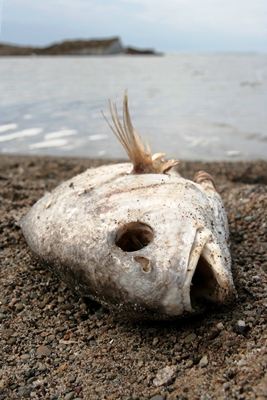
Water pollution was pervasive when the League was founded in 1922. One significant source of pollution was raw municipal waste being piped untreated into local waterways. League chapters and members across the country pursued state and local laws requiring waste treatment facilities. As reported by League Conservation Director Seth Gordon in March 1930, “The nationwide campaign for clean streams, lakes, and shores is making slow but sure progress. More has been accomplished during the past five years than at any time during the last half century. This is due largely to the campaign led by the Izaak Walton League. As a result of this effort, one state after another has revamped its laws and enlarged its facilities to handle this work efficiently.”
Although many cities were making progress, the pollution problem remained. A July 1932 article in Outdoor America reported “that more than 85 percent of our cities are still emptying their sewage untreated into streams. The fact that sewage volume has become much larger in the decades just past, due to greater concentration of population and increased industrial activity, has in a measure offset the gains made through elimination of pollution in some localities.”
After a study of sanitary laws across several states, the League drafted a Municipal Disposal Act to be used as model state legislation. The draft included language on financing sewage treatment plants by implementing a service charge on customers. The idea of municipalities constructing and operating treatment plants as public utilities was novel in many areas, although Michigan and Ohio had already adopted such legislation.
The League provided guidance on how cities could take advantage of funding from the federal Reconstruction Finance Corporation (RFC) — a New Deal program that facilitated construction of public improvements — to finance construction of sewage treatment plants. The League also provided advocates with strategies to garner public and political support for these projects — beyond just the environmental benefits: “[T]he average man has a tremendous capacity for indifference…. Hence he must be shown that prompt action in the building of modern, adequate sewage disposal systems . . . will save him money now, prevent possible future levies against property to pay for sewage plants later on, decrease the need for direct unemployment relief, circumvent possible costly suits from communities downstream, and transform sewage laden streams into clear, healthful rivers where a man can enjoy himself to his heart’s content.”
When the National Industrial Recovery Act was passed in 1933, the League urged cities to take advantage of grants for 30 percent of project costs for sewage treatment plants. Outdoor America reported that because of the great public values concerned, the Secretary of the Interior was providing preferential consideration to water supply and sewage projects.
From here, the League shifted focus to addressing water pollution on a national scale. Although waste treatment facilities had significantly improved water quality in some areas, there were bigger issues to tackle such as rampant industrial pollution. One of the centerpieces of the League’s conservation efforts during this era was a new law to make water pollution a federal issue.
Federal Water Pollution Law
The vision for a uniform national pollution policy was born at a 1934 meeting of the League’s Pennsylvania Division. IWLA National Vice President Dr. M. D’Arcy Magee attended the division meeting, where Grover Ladner was asked to speak about water pollution in the state. Ladner was known as a passionate and informed advocate for water quality (in 1935, as the state’s Deputy Attorney General, he would draft Pennsylvania’s Pure Streams Act — legislation that served as a model for other states). He was also a founder of the League’s Philadelphia Chapter and served as president of the chapter as well as a League national director.
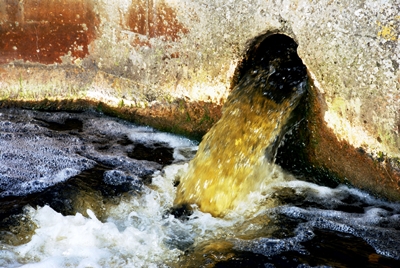
Ladner proposed a plan that would attack the pollution problem as a whole and provide for uniform enforcement and a means of raising funds for industry and municipalities to meet their pollution control requirements. The plan called for a Federal Board or Authority for every principal watershed in the country that would have enforcement authority over water pollution. In addition, the Authority would receive money from Congress to install sewage treatment plants in municipalities that could not finance them through bonds.
Magee was so impressed with these ideas that he asked Ladner to develop the plan to be presented by the League to national conservationists and members of Congress. Magee looked for a champion for such a proposal in Congress — and found one in Senator Augustine Lonergan (CT). Lonergan was already interested in water pollution issues. The previous year, he had written to President Roosevelt about the dangers to the country of widespread stream pollution and lack of standard enforcement.
Senator Lonergan called a meeting that included members of Congress, heads of government agencies, prominent sanitary engineers, representatives sent by the governors of several states, and Izaak Walton League leaders. The group discussed Ladner’s draft and developed a proposal for watershed boards made up of local representatives for each primary watershed. The plan recommend that a National Resources Board work with states on uniform water pollution laws, direct federal studies of interstate water issues, establish water pollution abatement districts (which would be called Sanitary Water Districts), and set minimum treatment requirements for each district. The plan also stated that discharge of “poisonous, deleterious, or polluting substances” that could injure public health or fish and wildlife would be “against the public policy of the United States.” In 1936, Senator Longergan introduced legislation to accomplish these objectives.
Over the course of the next decade, this legislation would change sponsors and titles several times and have numerous amendments added. The League was vocal in its support for federal water pollution legislation and urged its members to take action. In 1948, a very “watered down” version of the bill was approved by Congress that, in effect, declared “a five-year moratorium on continued industrial pollution — at an expense to the taxpayers of approximately $130 million,” decried IWLA Executive Director Ken Reid. “Congress has clearly evaded its responsibility to the public and attempted to administer a dose of soothing syrup while doing the bidding of those who want no interference with the continuance of their present polluting practices.”
But the League would not give up its fight for America’s waters.
No Dam on Public Values
The League also expended considerable effort during this period to ensure “public values” were considered by the Army Corps of Engineers before new dam construction was approved. For many years, the League had argued that the government needed a coordinated national water policy that would consider all values before authorizing or allowing construction to begin on large river developments undertaken by the Army Corps of Engineers, the Bureau of Reclamation, or “Valley Authorities” such as the Tennessee Valley Authority (TVA). In July 1946, League leaders testified before the Senate Committee on Agriculture and Forestry on behalf of a bill that would do just that. Shortly thereafter, the bill was approved by Congress and signed into law by President Truman. It was the first law to give statutory recognition of public aquatic values — which was especially critical given the massive river development happening at the time.
The law required biological surveys at the same time as engineering surveys and a full report on both to Congress. “The act is indeed a milestone in conservation accomplishment,” reported Outdoor America. “Enforcement of its provisions will put an end to the old destructive system of going right ahead with development and then, after its completion, allowing the biologists to come in for a post mortem on the dead body of the river.”
Recovering America’s Duck Populations
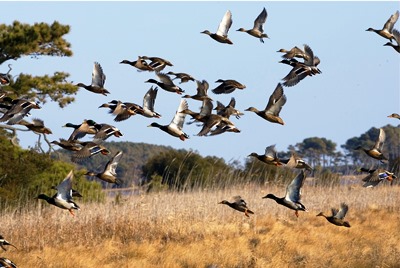
Agricultural expansion in the 1920s and drought conditions in the 1930s ravaged Midwest states, and the loss of wetlands and prairies decimated populations of waterfowl and other migratory birds. Migratory bird refuges were a long-term plan — one that lacked Congressional funding to move forward. So the League worked on new ideas to rescue and restore America’s waterfowl populations.
One way to do this was to lower bag limits for ducks and geese until populations could regain their strength. This was not a universally popular idea, but sportsmen in the League understood that duck populations could never recover without a respite. The League asked the Migratory Bird Treaty Advisory Board to recommend reduced bag limits and shorter hunting seasons to the Secretary of Agriculture. In February 1930, Outdoor America reported, “Score another victory for the organized conservation forces! Secretary Hyde has just announced a New Year’s gift to the ducks and geese of North America. It is exactly what the Izaak Walton League and Outdoor America have been fighting for — a bag limit of fifteen ducks and four geese a day, with a possession limit of thirty and eight respectively, so that the new law will be enforceable. This is much more than a victory! It is an acknowledgment of leadership…. The action of the Izaak Walton League was the first taken by any nationally recognized conservation organization.”
For the next several years, as waterfowl populations remained in danger, the League fought to keep bag limits low and hunting seasons short — even suggesting one year that the hunting season be eliminated altogether. Hatchlings were dying and adult birds were forced to abandon nesting areas and migrate north in search of water. In February 1932, the League proposed a “practical program to meet the waterfowl emergency” that included expediting appropriations for waterfowl refuges, closing areas on navigable streams to hunting to ensure rest and safety for ducks during migration, and using lands in “flood control projects” for resting and feeding areas. “In presenting its duck program, the Izaak Walton League stresses the recreational value and importance of hunting in America,” stated the program authors. “This remains the great traditional form of first-hand recreation for American citizens and is an essential part of our natural life.”
In 1932, delegates at the League’s national convention passed a resolution to raise funds for migratory bird sanctuaries “by imposition of an annual federal migratory bird stamp payable by all persons taking migratory birds.” Former Chairman of the League’s Executive Board, Willoughby Walling, testified before a special hearing of the U.S. Senate’s Special Committee on Wildlife about the League’s “practical program to meet the waterfowl emergency” and in support of the “duck stamp” as a means to raise funds to purchase additional waterfowl refuges.
In 1934, the Migratory Bird Hunting Stamp Act (commonly called the Duck Stamp Act) was passed by Congress and signed into law, providing for lands to be purchased by the federal government to be managed as “inviolate migratory bird sanctuaries” by the Bureau of Biological Survey. Every duck hunter age 16 and older would be required to purchase a $1 stamp. The first stamp was designed by League leader J.N. “Ding” Darling.
As new refuges were acquired to benefit waterfowl and other wildlife, the League advocated for opening portions of the refuges to public hunting. In 1949, President Truman signed the Johnson-Thompson bill into law, which raised the price of the duck stamp to $2 and stated that the extra money should be used to acquire, develop, maintain, and administer refuges and management areas for migratory birds. The law also stated that up to 25 percent of any refuge area acquired under the new statute could be opened to public hunting.
Funding Wildlife Restoration
The League passed a resolution at the 1937 national convention endorsing The Federal Aid in Wildlife Restoration Act — better known today as the Pittman-Robertson Act after its principal sponsors, Senator Key Pittman (NV) and Representative A. Willis Robertson (VA), a League member. The goal of the legislation was to redirect an excise tax on firearms and ammunition to support state efforts to improve management and restoration of wildlife.
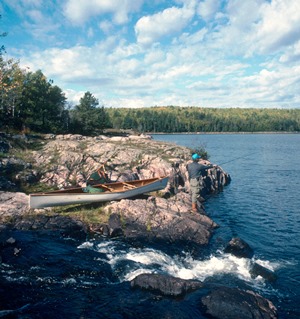
The League urged its members across the country to speak up in support of the bill: “All it needs to become a reality is the help of the thousands of wildlife enthusiasts who must convince Congress that they want ACTION this session.” The legislation was signed into law by President Franklin Roosevelt in September 1937. The law was later amended to include excise taxes on handguns and archery equipment. The Act also stipulated that for states to receive federal funds, money raised from the sale of hunting licenses must be used for wildlife projects.
In just 10 years, states used Pittman- Robertson funds to purchase 900,000 acres of habitat, plant trees and grasses, and restock deer, pronghorn, elk, mountain goats, and mountain sheep to restored areas. Other activities funded by the Pittman-Robertson Act included research into wildlife problems and the establishment of hunter education programs.
Following the successful implementation of Pittman-Robertson, the League raised the possibility of a similar arrangement to benefit sport fish. With the advent of World War II, Congress passed a law that imposed a 10-percent excise tax on rods, reels, creels, and artificial lures to help fund the war effort. When the war ended in 1945, however, the federal government continued to collect funds from the excise tax but deposited them into the General Fund.
In 1947, Congressman John Dingell, Sr. (MI) introduced legislation to dedicate these funds to conservation. After several unsuccessful attempts to enact this legislation, President Truman signed the Federal Aid in Sport Fish Restoration Act (also known as the Dingell- Johnson Act) into law in 1950. The excise taxes collected on fishing tackle and equipment were now to be put into a special account for apportionment to the states for sport fish restoration programs. Similar to Pittman- Robertson, this act also stipulated that to receive federal funds, states should use fishing license fees to support sport fishing.
Saving Superior National Forest
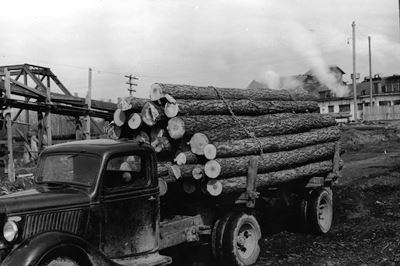
The idea that protecting areas of true “wilderness” was in the public’s best interest — and what such “wilderness” areas should look like — matured during battles to prevent development in Superior National Forest in the 1930s and 40s.
In the mid-1920s, a power company proposed using lakes in Superior National Forest to generate hydropower. That process would have involved damming the border lakes and raising water levels 4 to 60 feet. The League worked with the Quetico- Superior Council on federal legislation to block development for hydropower in Superior National Forest. The resulting Shipstead-Newton-Nolan bill was signed into law by President Hoover in 1930. The law prohibited flooding of federal lands in the boundary waters between Minnesota and Ontario without Congressional approval. It was also the first time Congress ordered federal land to be retained in its wilderness state, and the law set a precedent for protecting the natural beauty of forest lakes by prohibiting timber harvest within 300 feet of the shoreline.
However, this was just the first volley in a battle to maintain the wilderness and recreation values of the Quetico-Superior region. At risk were 2.5 million acres in Minnesota and nearly 7.5 million acres in Ontario. Throughout the 1930s, business interests pursued use of the area’s lakes to develop hydropower and use of its forests for pulp. The League worked to block these uses of the forest and to secure federal appropriations to purchase private holdings in Superior National Forest. When funding was not forthcoming, due first to the depression and next to World War II, the League started a fundraising campaign.
Between 1945 and 1949, the Izaak Walton League of America Endowment (incorporated in 1943) raised and spent approximately $90,000 to purchase private lands within the forest’s roadless area — land that would later be repurchased by the U.S. Forest Service. Minnesota members of the League selected the land and negotiated sales. League members even made personal purchases of land that they later donated to the Forest Service. These purchases helped secure the roadless area that would later be protected as the Boundary Waters Canoe Area Wilderness.
The League also secured an agreement with the government of Ontario to preserve the wilderness values of the Canadian side of the boundary lakes. A lumber company received approval in 1941 to log Quetico Provincial Park as part of the war supply effort. League Executive Director Ken Reid traveled to Canada in November 1941 to meet with the Deputy Minister of Lands and Forests for Ontario, Hon. Frank MacDougall. “We found then, as we suspected, that there was no chance of preventing or stopping the logging in the Quetico, but only of regulating it,” Reid reported. However, he was able to secure a promise from MacDougall that the operation would maintain 300-foot no-cutting strips along all of the canoe routes in the interior as well as along the boundary waters.
Forties End With a Double Victory
As the 1940s drew to a close, Ikes celebrated two hard-fought victories. The first involved Jackson Hole, Wyoming. National Park Service Director Horace Albright fell in love with Jackson Hole back when he was working as the supervisor of Yellowstone National Park. He was worried that the landscape would be developed and lose its natural qualities. So he brought in Laurence Rockefeller, who had already donated other lands to the National Park Service. In the late 1920s, Rockefeller agreed to start buying up private land to hold for a future national park. But when President Calvin Coolidge signed the bill creating Grand Teton National Park, these lands were not included.
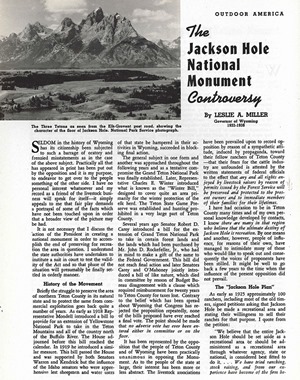
Albright concluded that the only way to save Jackson Hole was by using the Antiquities Act to create a national monument. After some political maneuvering, President Roosevelt issued a proclamation in 1943 creating the Jackson Hole National Monument. This created significant backlash not only against the monument but even the previously established Grand Teton National Park. League leaders studied the issue and declared, “After a most careful study, the League can find no grounds for opposing the Jackson Hole monument, but on the contrary, believes that the public interest will be definitely served by consolidating the management of this area under the one federal bureau.” At the forefront of the battle to preserve the Jackson Hole monument, the League fought for funds to improve and administer the area “so it can achieve its highest aesthetic and economic purpose in furnishing enjoyment and inspiration to the public.”
In December 1949, Laurence Rockefeller presented the National Park Service with the deed to 30,000 acres of land in the Jackson Hole valley, with the requirement that these lands be administered by the Park Service in perpetuity. This “came almost as an anticlimax, not in the halls of Congress nor in a bloody six-gun affray ‘out west,’ but in a pleasant, cordial ceremony in Washington,” reported League Executive Director William Voigt, Jr. Jackson Hole National Monument withstood the efforts to abolish it and was ultimately incorporated into Grand Teton National Park by an act of Congress.
Also in December 1949, President Truman signed an Executive Order creating an “Air Space Reservation” over the roadless areas of Superior National Forest, halting all flights over the area other than government flights and emergency or rescue operations. All future flights would have to maintain an elevation of 2,000 feet. “The recent Air Space Reservation, the first of its kind in the history of the world, not only recognizes the value of all wilderness, but gives new incentive to the Quetico-Superior program and is a major victory for the Izaak Walton League and dozens of other individuals and organizations who have given so much time, money, and effort to preserving the wilderness canoe country,” wrote Sig Olson, the League’s Wilderness Ecologist, in Outdoor America.
At the end of the 1940s, the League wore the scars of long battles — some successful and some that would continue — to conserve America’s natural resources. The coming decades would bring renewed efforts to secure effective national clean water legislation and efforts to improve soil health and air quality across the country.